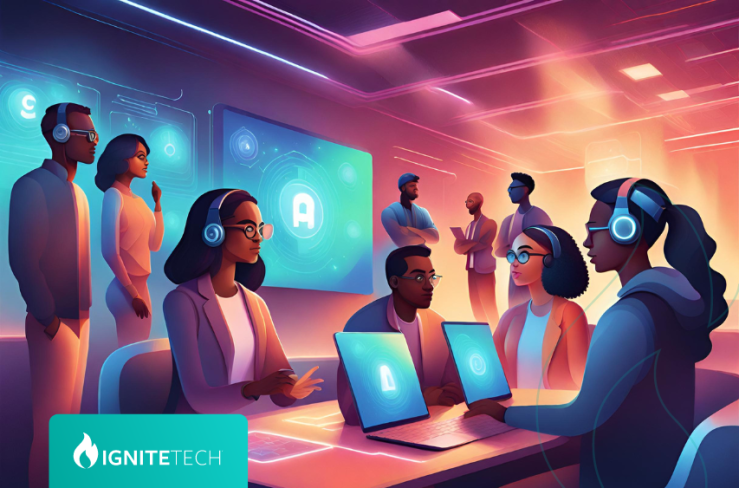Before the COVID-19 lockdowns, many companies were moving toward automation and using technology to improve customer service functions. During the stay-at-home orders and aftermath, companies accelerated their digital technology initiatives. McKinsey reports that in less than a year, some companies achieved seven years of progress.
Innovating the customer service experience at a rapid pace continues, especially from the customers’ point of view. Customers don’t want to be treated like a ticket, tossed among departments and different agents. They view their interaction with the company, no matter from what channel, as part of an ongoing conversation. Today customer service is evolving from a siloed ticket-based approach to a more conversational flow.
Say hello and join the conversation in what some experts call the conversational age for customer service.
We’ll explore four tips to help you optimize this new conversation with customers. Keep in mind that a fundamental tool to help your agents succeed is providing them with the ability to see the customer’s history all in one place with a tool like Kayako’s Single View. Serving customers across different channels is critical, too.
But first, let’s go over what is conversational customer service and engagement and why it matters.
WHAT IS CONVERSATIONAL CUSTOMER SERVICE?
Conversational customer service refers to using technology, such as conversational support software, to create an experience that feels like a conversation rather than a series of disjointed interactions. Conversations are essential in improving the customer journey, leading to higher brand loyalty and longer customer lifetime value.
The best way to understand conversational customer engagement is to think about it from the customer’s point of view. A customer has an issue they need help with. To them, this is the start of a conversation, from the first call to the final resolution and even beyond. Customers don’t think of the service function from the company’s point of view, where resources and people to solve a problem may be spread across a department or organization.
As in any relationship, conversational customer service implies many customer conversations over time. To be a good partner, companies need to keep track of the context of past interactions so they can develop satisfying conversations in the future.
WHY IS IT IMPORTANT TO PROVIDE CONVERSATIONAL SUPPORT?
Conversational support is essential to customer relationship management because the quality of the conversation defines a customer’s experience, which influences customer retention and loyalty.
Think about how you feel when you chat with a friend who can never remember the details of your past conversations. It makes you feel like they haven’t been listening, doesn’t it? According to HubSpot, 33% of customers say they don’t want to repeat information they’ve already shared.
In customer service, needing to repeat themselves makes customers feel like they haven’t been heard. It also gives the impression that the company is not organized and hasn’t prioritized resources to equip its agents to provide a better experience.
A good customer service conversation includes attentive listening, recall of details, empathy, and agent empowerment to pull together resources for a quick resolution.
While technology can’t replace agents well-trained in soft skills, all the soft skills in the world don’t do any good if the agent doesn’t have the right tools at their fingertips to create a robust conversational flow confidently.
HOW DO YOU IMPLEMENT CONVERSATIONAL CUSTOMER ENGAGEMENT?
So now that we understand the importance of conversational support, what practical steps can companies take to create a supportive workflow that enables great conversations?
1. Map Your Customer Journey
You know that feeling when you start watching a movie in the middle and have no idea what’s going on? If you ever do, it can take several minutes to catch up on the context. You also annoy your partner, who has been watching from the beginning and doesn’t want to repeat what has happened.
The same thing can happen if you try to implement conversational customer service without first considering the customer’s journey. Their journey is the total of their experiences with the company and especially the current service issue.
Since the late 1990s, some companies have used created customer journey maps. Mapping the customer journey gives the company a visual tool to use that illustrates the different touch points. It can map out possible different directions a customer may go in interacting with the company.
Much like a real map, it can help companies maximize positive touchpoints. More importantly, the customer journey map can reduce customer attrition by helping retain customers before they take their business elsewhere.
Mapping the customer journey is a valuable tool because it helps marketing and management review the customer experience from the customer’s point of view, not just from the company’s.
At the agent level, understanding the customer journey can help service agents create context around service calls. Do you have more questions about mapping the customer journey as a first step to helping agents be more conversational with customers? Check out this blog article for an in-depth look at how to map the customer journey.
2. Provide an Omnichannel Experience
Think about how people have conversations today – in person, on the phone, over text and other messaging apps, via email, and on social media. People often switch devices during the same conversation, especially mobile devices.
Your customers’ expectations about conversations regarding service issues are no different. Forbes research shows that 71% of customers want a consistent experience across channels. When customers contact a brand, they aren’t thinking, “What channel am I using?” they are thinking about starting a conversation to get help or support.
Technology continues to evolve across channels. For example, AI-enhanced chatbots are improving over early versions that could not have satisfactory customer conversations.
The best way to manage omnichannel complexity is with a strategy and the right tools. You can see how Kayako helped CoinStop reduce average response time and implement omnichannel customer support in this case study.
3. Use Context to Deliver Personalized Customer Interactions
Knowing the context of a situation is essential to personalizing customer interaction. Personalization is important because it directly affects customer retention and attrition. In fact, 71% of customers are frustrated by impersonal shopping experiences, and 66% of consumers expect brands to understand their individual needs.
In addition to providing an omnichannel experience, other keys to personalization include:
- A tool for agents to visualize the customer journey in one place.
- Make it easy for customers to help themselves with self-help tools.
- Monitor customer satisfaction to see what is working and catch red flags.
From the service agent’s perspective, customer context is essential to helping them establish a valuable support conversation that treats the customer as an individual, not just a support ticket.
4. Help Customers with Frictionless and Effortless Conversations
Much like it sounds, friction is any point in the customer’s journey that causes dissatisfaction. In the most basic concept, providing frictionless customer service means tracking the customer journey and enhancing the customer experience. When companies treat customer service as a conversation rather than a disjointed series of inquiries, the result is less friction and happier customers and service agents.
Frictionless customer experiences are also important for customer retention and customer lifetime value. Gartner reports that 96% of customers experiencing high friction with a company are more likely to become disloyal, purchase less in the future, and spread negative information to discourage others from becoming customers.
Ways to reduce friction for the customer include equipping agents to minimize back and forth for the customer. Kayako allows customer service agents to access other experts and stakeholders inside and outside the company to report back to the customer with the most current information possible.
THE BOTTOM LINE
Customers want to have personalized, efficient conversations with your company across different channels. Companies are moving from a service-ticket mindset to nurturing customer relationships over time via conversations. To deliver frictionless experiences, service agents need the right tools.
Are you ready to increase your team’s efficiency? Provide a better employee experience and speed up internal support with Kayako HelpDesk. Discover Kayako.






